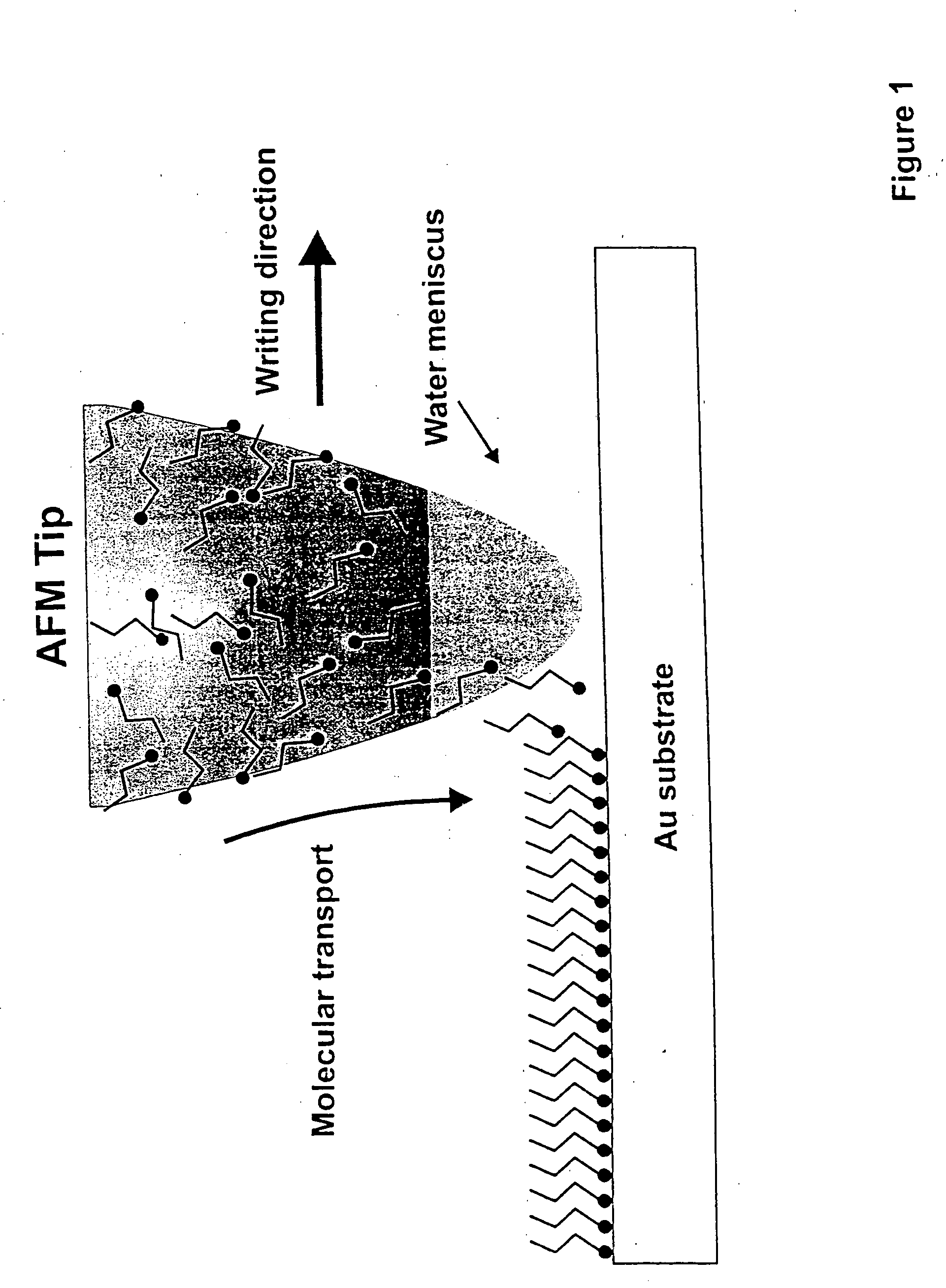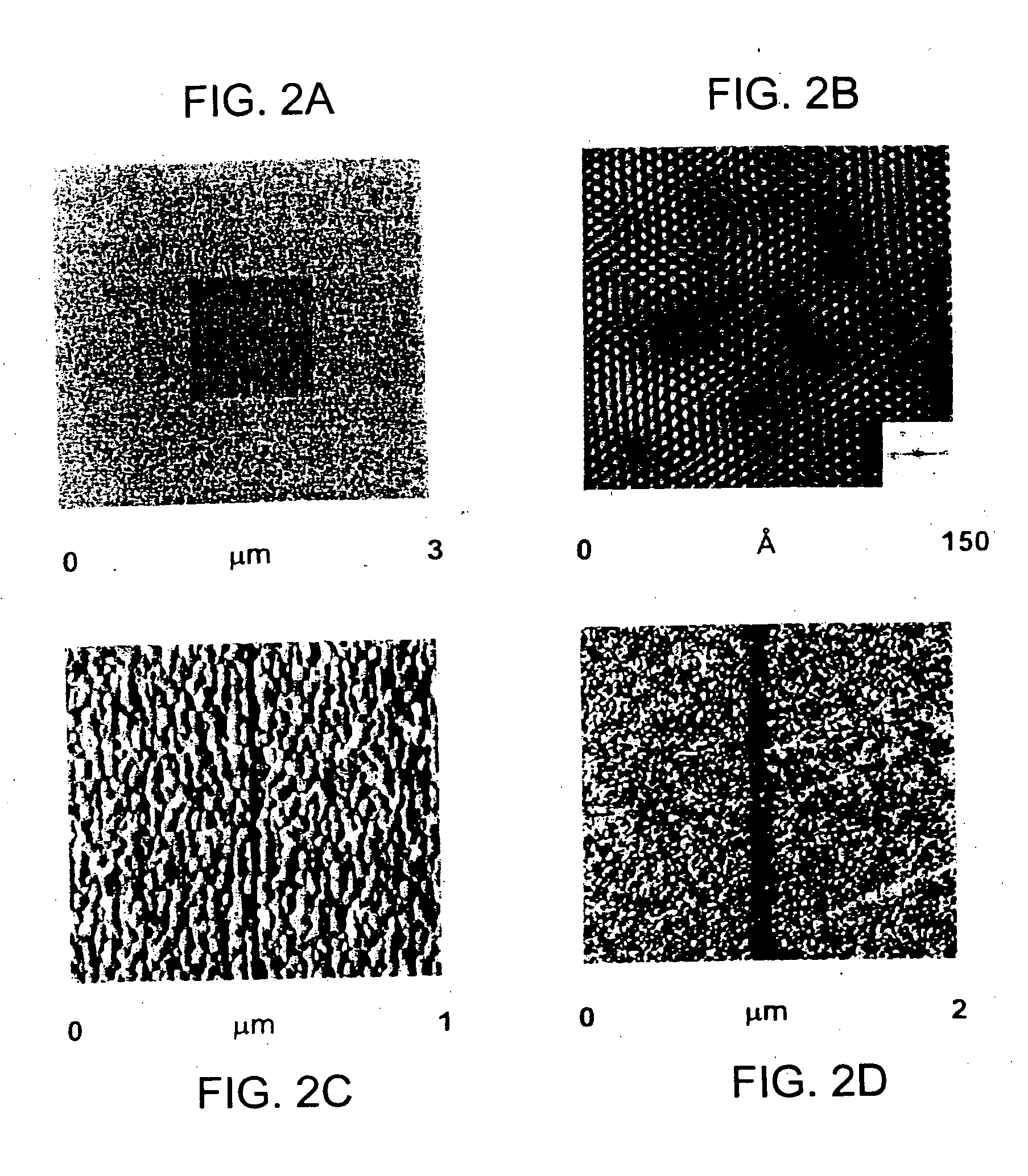Methods utilizing scanning probe microscope tips and products thereof or produced thereby
- Summary
- Abstract
- Description
- Claims
- Application Information
AI Technical Summary
Benefits of technology
Problems solved by technology
Method used
Image
Examples
example 1
“Dip Pen” Nanolithography With Alkanethiols On A Gold Substrate
[0134] The transfer of 1-octadecanethiol (ODT) to gold (Au) surfaces is a system that has been studied extensively. See Bain et al., Angew. Chem. Int. Ed. Engl., 28:506 (1989); A. Ulman, An Introduction to Ultrathin Organic Films: From Langmuir-Blodgett to Self-Assembly (Academic Press, Boston, 1991); Dubois et al., Annu. Rev. Phys. Chem., 43:437 (1992); Bishop et al., Curr. Opin. Coll. Interf Sci., 1:127 (1996); Alves et al., J. Am. Chem. Soc. 114:1222 (1992). Au having this moderately-air-stable molecule immobilized on it can be easily differentiated from unmodified Au by means of lateral force microscopy (LFM).
[0135] When an AFM tip coated with ODT is brought into contact with a sample surface, the ODT flows from the tip to the sample by capillary action, much like a dip pen (FIG. 1). This process has been studied using a conventional AFM tip on thin film substrates that were prepared by thermally evaporating 300 Å ...
example 2
“Dip Pen” Nanolithography With A Variety Of Substrates And “Inks”
[0142] A large number of compounds and substrates have been successfully utilized in DPN. They are listed below in Table 1, along with possible uses for the combinations of compounds and substrates.
[0143] AFM tips (Park Scientific) were used. The tips were silicon tips, silicon nitride tips, and silicon nitride tips coated with a 10 nm layer of titanium to enhance physisorption of patterning compounds. The silicon nitride tips were coated with the titanium by vacuum deposition as described in Holland, Vacuum Deposition Of Thin Films (Wiley, New York, N.Y., 1956). It should be noted that coating the silicon nitride tips with titanium made the tips dull and decreased the resolution of DPN. However, titanium-coated tips are useful when water is used as the solvent for a patterning compound. DPN performed with uncoated silicon nitride tips gave the best resolution (as low as about 10 nm).
example 3
Atomic Force Microscopy With Coated Tips
[0150] As noted above, when an AFM is operated in air, water condenses between the tip and surface and then is transported by means of the capillary as the tip is scanned across the surface. Piner et al., Langmuir 13, 6864-6868 (1997). Notably, this filled capillary, and the capillary force associated with it, significantly impede the operation of the AFM, especially when run in lateral force mode. Noy et al., J. Am. Chem. Soc. 117, 7943-7951 (1995); Wilbur et al., Langmuir 11, 825-831 (1995). In air, the capillary force can be 10 times larger than chemical adhesion force between tip and sample. Therefore, the capillary force can substantially affect the structure of the sample and the imaging process. To make matters worse, the magnitude of this effect will depend on many variables, including the relative hydrophobicities of the tip and sample, the relative humidity, and the scan speed. For these reasons, many groups have chosen to work in s...
PUM
 Login to View More
Login to View More Abstract
Description
Claims
Application Information
 Login to View More
Login to View More - R&D
- Intellectual Property
- Life Sciences
- Materials
- Tech Scout
- Unparalleled Data Quality
- Higher Quality Content
- 60% Fewer Hallucinations
Browse by: Latest US Patents, China's latest patents, Technical Efficacy Thesaurus, Application Domain, Technology Topic, Popular Technical Reports.
© 2025 PatSnap. All rights reserved.Legal|Privacy policy|Modern Slavery Act Transparency Statement|Sitemap|About US| Contact US: help@patsnap.com



